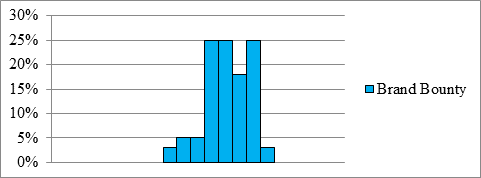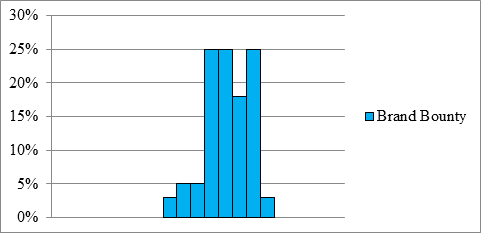
a.
To know that in a random sample of 30 Bounty paper towels and a random sample of 30 generic paper towels, the manufacturer claims that they are the "quicker picker-upper," but are they also the stronger picker-upper? And also to know would it be appropriate to use frequency histograms instead of relative frequency histograms in this setting.
a.
Answer to Problem 76E
Yes, it would be appropriate to use frequency histograms instead of relative frequency histograms in this setting.
Explanation of Solution
Given a random sample of 30 Bounty paper towels and a random sample of 30 generic paper towels and measured their strength when wet. To do this, they uniformly soaked each paper towel with 4 ounces of water, held two opposite edges of the paper towel, and counted how many quarters each paper towel could hold until ripping, alternating brands. The data are displayed in the relative frequency histogram shown below:


It would be appropriate to use frequency histograms instead of relative frequency histograms, because the two histograms are based on the same number of data values (as there are 30 Bounty paper towels and 30 Generic paper towels in the two samples). Since these two histograms would be based on the same number of data values, we would be able to compare the frequency histograms.
b.
To know that in a random sample of 30 Bounty paper towels and a random sample of 30 generic paper towels, the manufacturer claims that they are the "quicker picker-upper," but are they also the stronger picker-upper? And also to compare the distributions of number of quarters until breaking for the two paper towel brands.
b.
Answer to Problem 76E
The generic distribution is roughly symmetric, while the bounty distribution is skewed to the left.
Neither distribution appears to contain any outliers.
The center of the generic distribution is roughly at 90 quarters, while we expect the center of the bounty distribution to be roughly at 120 quarters.
The spread of the both distributions appears to be roughly the same.
Explanation of Solution
Given a random sample of 30 Bounty paper towels and a random sample of 30 generic paper towels and measured their strength when wet. To do this, they uniformly soaked each paper towel with 4 ounces of water, held two opposite edges of the paper towel, and counted how many quarters each paper towel could hold until ripping, alternating brands. The data are displayed in the relative frequency histogram shown below:


The generic distribution is roughly symmetric, because the highest bars are roughly in the middle of the distribution as shown in the histogram above. The bounty distribution is skewed to the left, because the highest bars are to the right in the histogram above with a tail of smaller bars to the left.
Neither distribution appears to contain any outliers, because there are no gaps in the histograms shown above.
The center of the generic distribution is roughly at 90 quarters, as we expect the center to be roughly at the highest bar in the histogram. Similarly, we expect the center of the bounty distribution to be roughly at 120 quarters.
The spread of the both distributions appears to be roughly the same, because one distribution uses 7 bars and the other distribution uses 8 bars of the same width in the histogram.
Chapter 1 Solutions
PRACTICE OF STATISTICS F/AP EXAM
Additional Math Textbook Solutions
An Introduction to Mathematical Statistics and Its Applications (6th Edition)
Introductory Statistics
Statistics for Business and Economics (13th Edition)
Elementary Statistics: Picturing the World (6th Edition)
Statistics for Psychology
Elementary Statistics (13th Edition)
 MATLAB: An Introduction with ApplicationsStatisticsISBN:9781119256830Author:Amos GilatPublisher:John Wiley & Sons Inc
MATLAB: An Introduction with ApplicationsStatisticsISBN:9781119256830Author:Amos GilatPublisher:John Wiley & Sons Inc Probability and Statistics for Engineering and th...StatisticsISBN:9781305251809Author:Jay L. DevorePublisher:Cengage Learning
Probability and Statistics for Engineering and th...StatisticsISBN:9781305251809Author:Jay L. DevorePublisher:Cengage Learning Statistics for The Behavioral Sciences (MindTap C...StatisticsISBN:9781305504912Author:Frederick J Gravetter, Larry B. WallnauPublisher:Cengage Learning
Statistics for The Behavioral Sciences (MindTap C...StatisticsISBN:9781305504912Author:Frederick J Gravetter, Larry B. WallnauPublisher:Cengage Learning Elementary Statistics: Picturing the World (7th E...StatisticsISBN:9780134683416Author:Ron Larson, Betsy FarberPublisher:PEARSON
Elementary Statistics: Picturing the World (7th E...StatisticsISBN:9780134683416Author:Ron Larson, Betsy FarberPublisher:PEARSON The Basic Practice of StatisticsStatisticsISBN:9781319042578Author:David S. Moore, William I. Notz, Michael A. FlignerPublisher:W. H. Freeman
The Basic Practice of StatisticsStatisticsISBN:9781319042578Author:David S. Moore, William I. Notz, Michael A. FlignerPublisher:W. H. Freeman Introduction to the Practice of StatisticsStatisticsISBN:9781319013387Author:David S. Moore, George P. McCabe, Bruce A. CraigPublisher:W. H. Freeman
Introduction to the Practice of StatisticsStatisticsISBN:9781319013387Author:David S. Moore, George P. McCabe, Bruce A. CraigPublisher:W. H. Freeman





